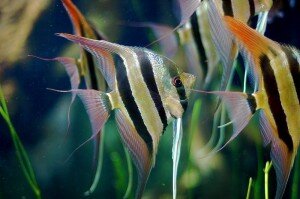About Angelfish Care
Since the scalare angelfish is the most common, most of what is known about angelfish care is based on the scalare angelfish. In general this freshwater tank fish needs a tall tank to accommodate its tall fins, and conditions that mimic the Amazonian rivers and tributaries where they are from. With good care, the scalare angelfish is known to have a lifespan of 10 years, sometimes longer.
Below is the basic care for each of the three angelfish species. Keep in mind that when putting your fish into the minimum tank size, you will need to do partial water changes once a week or the water will become toxic quickly.
Also, these care notes are for regular care, not breeding angelfish. Read more about angelfish care when breeding here.

Scalare freshwater angelfish are easy to care for. Photo by Shizhao, Wikipedia commons
Scalare Angelfish Care (Pterophyllum scalare)
General care: easy, hardy, adaptable
Cost to purchase: $5 to $30 depending on variety
Tank size: minimum of 35 gallons for two fish
Fish tank set up: water should not flow too fast, need lots of plants for hiding. They need lots of space to swim and hide.
Temperature: 70 to 85 degrees F. They do prefer temperatures on the higher end of that range of about 76 to 80 degrees F. If they feel a chill, they’ll stay closer to the water heater rather than swim around the tank.
pH: slightly acidic, 6.5 to 7.2
Water hardness: soft to medium
Blackwater: not necessary as their ancestors may have come from whitewater or clearwater habitats, but the fish may prefer it. Adding peat moss or using a blackwater tonic will help increase the acidity slightly and soften the water.
Feeding: omnivores. Feed fish flakes, brine shrimp frozen or alive, bloodworms, glassworms, tubifex worms, daphnia and slices of veggies such as zucchini or peas. Live plants and smaller fish in the tank will also be natural food sources.
Determining gender: not easy. You may not be able to confirm the sex of your angelfish until your fish have produced live fry. If you have a school of angelfish, usually males and females will pair off. Older males may have a prominent bump on their forehead. Read more about sexing your angelfish in breeding angelfish.

Altum angelfish are a more challenging species to care for. Photo by Jeff Kubina, Wikipedia commons
Altum Angel Care (Pterophyllum altum)
General care: challenging
Cost: $40+
Tank size: minimum 50 gallons
Fish tank set up: places to hide, tall plants, water should circulate but not flow too fast, bogwood is often recommended for altum angels. Provide plenty of space to swim and hide.
Temperature: 80 to 88 F, with a preference for 82 to 86 degrees F. These fish are not as adaptable to temperature fluctuations as scalare.
pH: acidic, 4.2 to 6.2
Water hardness: very soft to soft (1 to 5 dH). Some believe they do best in the exact water conditions of their wild habitat. If your altum angelfish are wild caught, ask what river they came from and its conditions.
Blackwater: Ideal for altums. Helps to meet the pH and very soft water needs of the altum. Bogwood can also be added to add tannins and soften the water.
Feeding: omnivores. Prefer live foods and fresh vegetation, especially if wild caught.
Determining gender: difficult. Unless your fish have produced live fry, you may not be able to confirm the gender. If you have a school of angelfish, males and females will pair off. Older males may have a prominent bump on their forehead. Read more about sexing your angelfish in breeding angelfish.
Notes: Quarantine is especially important for this species. Because many are still imported from the wild, they are more likely to have diseases and parasites you don’t want transmitted to your entire tank.
Change 20 percent of the water every week. Some aquarists have noted that skipping weekly water changes will cause altums to stop eating.

Leopold’s angelfish are rare to find and difficult to care for. Photo by Hodowlaniec at pl.wikipedia
Leopold’s Angelfish Care (Pterophyllum leopoldi)
General care: very challenging. There are so few in captivity that there is limited information specific to the care of the leopoldi angelfish.
Cost: $40+, rarely seen
Tank size: minimum 35 gallons
Fish tank set up: places to hide, tall plants, water should circulate but not flow too fast, bogwood is often recommended for altum angels. They need space to swim about and hide.
Temperature: 77 to 87 degrees F
pH: slightly acidic, 6.6 to 7.0
Hardness: soft
Blackwater: yes
Feeding: omnivores. Start by feeding live foods, such as brine shrimp, and fresh produce. These wild caught fish may only eat fresh foods similar to their natural food sources. You may be able to transition them to a mix of fish flakes, live and frozen foods, and vegetable matter over time.
Determining gender: difficult and reports of successful breeding of leopoldi angelfish in captivity is scarce.
Notes: Most Leopold’s angelfish are wild caught making quarantine a must. They are likely to have parasites and diseases obtained in the wild or during shipment. If you do not quarantine, you will transmit these conditions to your entire tank of fish.
